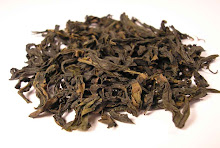
Tea is the agricultural product of the leaves, leaf buds, and internodes of the Camellia sinensis plant, prepared and cured by various methods. "Tea" also refers to the aromatic beverage prepared from the cured leaves by combination with hot or boiling water, and is the common name for the Camellia sinensis plant itself.
After water, tea is the most widely-consumed beverage in the world. It has a cooling, astringent flavour which many enjoy.
There are at least six varieties of tea; white, yellow, green, oolong, black and pu-erh of which the most commonly found on the market are white, green, oolong and black. All tea are made from the same bushes but processed differently, and, in the case of fine white tea, grown differently. Pu-erh tea, a post-fermented tea, is also often used medicinally.
The term "herbal tea" usually refers to an infusion or tisane of leaves, flowers, fruit, herbs or other plant material that contains no Camellia sinensis. The term "red tea" refers to an infusion made from either black tea (mainly in Chinese, Korean, Japanese and other East Asian languages) or the South African rooibos plant (containing no Camellia sinensis).
After water, tea is the most widely-consumed beverage in the world. It has a cooling, astringent flavour which many enjoy.
There are at least six varieties of tea; white, yellow, green, oolong, black and pu-erh of which the most commonly found on the market are white, green, oolong and black. All tea are made from the same bushes but processed differently, and, in the case of fine white tea, grown differently. Pu-erh tea, a post-fermented tea, is also often used medicinally.
The term "herbal tea" usually refers to an infusion or tisane of leaves, flowers, fruit, herbs or other plant material that contains no Camellia sinensis. The term "red tea" refers to an infusion made from either black tea (mainly in Chinese, Korean, Japanese and other East Asian languages) or the South African rooibos plant (containing no Camellia sinensis).







No comments:
Post a Comment